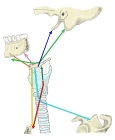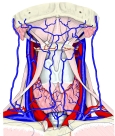顎二腹筋 ( がくにふくきん、 英 : digastric muscle )
・ 概 要 |
・ 作 用 |
・ イラスト掲載サイ |
|
・ イラスト |
・ 神経 / 脈管 |
||
・ 起始 / 停止 |
・ Wikipedia |


・ 下顎の直下に位置する。
・ いわゆる二腹筋の1つで、その他の二腹筋としては 肩甲舌骨筋 や 後頭前頭筋 などがある。


・ 「 鼓室中の アブミ骨筋 は顎二腹筋の後腹から分かれたものである。」 ( 日本人体解剖学 )
【 前腹と後腹の違い 】 参考 : Wikipedia
・ 後腹の方が前腹よりも長い。
・ 発生学 (embyology) 的には、前腹は 第1咽頭弓 に、後腹は 第2咽頭弓 に由来している。
※ 起始や神経支配なども異なるが、それらに関しては下の「 神経・脈管 」を参照のこと。
![]()
顎下三角は 顎下腺 や 顎下リンパ節 などを容れている。
 |
 |
 |
 |
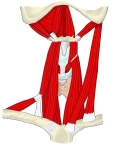 |
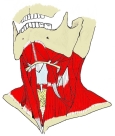 |
【 起 始 】: 前腹 : 二腹筋窩 ( 下顎骨 ) 後腹 : 乳突切痕 ( 側頭骨 )
前腹は起始部より後外側方に、そして後腹は起始部より前下方に走って中間腱に向かう。
【 停 止 】: 中間腱?

|

|

|
「 舌骨を引き上げ、また舌骨を固定するときは下顎骨を下方に引き咀嚼 ( mastication ) を助ける。」 ( 日本人体解剖学 )
・ 神 経 : 前腹 : 顎舌骨筋神経 ( 下顎神経( 三叉神経の第3枝 )の枝の 下歯槽神経 の枝 )
後腹 : 顔面神経 の 二腹筋枝
・ 静 脈 : 顔面静脈 に流れ込む オトガイ下静脈 あたりだと思われるが、詳細は不明。
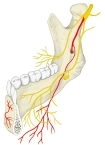
|
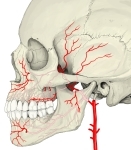
|
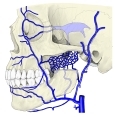
|
The digastric muscle ( also digastricus ) ( named digastric as it has two 'bellies' ) is a small muscle located under the jaw. The term "digastric muscle" refers to this specific muscle. However, other muscles that have two separate muscle bellies include the ligament of Treitz, omohyoid, occipitofrontalis.
It lies below the body of the mandible, and extends, in a curved form, from the mastoid notch to the symphysis menti. It belongs to the suprahyoid muscles group.
A broad aponeurotic layer is given off from the tendon of the digastricus on either side, to be attached to the body and greater cornu of the hyoid bone ; this is termed the suprahyoid aponeurosis.
The digastricus ( digastric muscle ) consists of two muscular bellies united by an intermediate rounded tendon.
The two bellies of the digastric muscle have different embryological origins, and are supplied by different cranial nerves.
Each person has a right and left digastric muscle. In most anatomical discussions, the singular is used to refer to a muscle, even when each person actually has two of that muscle—one on the right side, and another on the left. For example, we speak of the deltoid, even though there is one deltoid in each shoulder. Likewise, we speak of the digastric even though there is a right and left digastric muscle.
【 語 句 】
・ ligament of Treitz : = suspensory muscle of duodenum( 十二指腸提筋 ) ・ omohyoid : 肩甲舌骨筋 ・ occipitofrontalis : 後頭前頭筋 ・ mandible : 下顎骨 ・ mastoid notch : 乳突切痕 ・ symphysis menti : 下顎結合 ・ suprahyoid muscles group : 舌骨上筋群 ・ aponeurotic : 腱膜の ・ digastricus : 顎二腹筋? ・ greater cornu of the hyoid bone : 舌骨の大角 ・ suprahyoid aponeurosis : 舌骨上腱膜 ・ embryological : 発生学的な ・ cranial nerves : 脳神経 ・ Likewise : 同様に
【 Posterior belly 】
The posterior belly, longer than the anterior belly, arises from the mastoid notch which is on the inferior surface of the skull, medial to the mastoid process of the temporal bone. The mastoid notch is a deep groove between the mastoid process and the styloid process. The mastoid notch is also referred to as the digastric groove or the digastric fossa.
The posterior belly is supplied by the digastric branch of facial nerve.
The digastric muscle stretches between the mastoid process of the cranium to the mandible at the chin, and part-way between, it becomes a tendon which passes through a tendinous pulley attached to the hyoid bone. It originates from the second pharyngeal arch.
【 Anterior belly 】
The anterior belly arises from a depression on the inner side of the lower border of the mandible called the digastric fossa of mandible, close to the symphysis, and passes downward and backward.
The anterior body is supplied by the trigeminal via the mylohyoid nerve, a branch of the inferior alveolar nerve, itself a branch of the mandibular division of the trigeminal nerve. It originates from the first pharyngeal arch.
【 語 句 】
・ mastoid notch : 乳突切痕 ・ mastoid process of the temporal bone : 側頭骨の乳様突起 ・ groove : 溝 ・ styloid process : 茎状突起 ・ pulley : 滑車 ・ hyoid bone : 舌骨 ・ pharyngeal arch : 咽頭弓 ・ depression : くぼみ ・ digastric fossa : 二腹筋窩 ・ symphysis : 線維軟骨結合? ・ trigeminal : 三叉神経 ・ mylohyoid nerve : 顎舌骨筋神経 ・ inferior alveolar nerve : 下歯槽神経
【 Intermediate tendon 】
The two bellies end in an intermediate tendon which perforates the stylohyoideus muscle, and is held in connection with the side of the body and the greater cornu of the hyoid bone by a fibrous loop, which is sometimes lined by a mucous sheath.
【 Variations 】
Variations are numerous.
The posterior belly may arise partly or entirely from the styloid process, or be connected by a slip to the middle or inferior constrictor ; the anterior belly may be double or extra slips from this belly may pass to the jaw or mylohyoideus or decussate with a similar slip on opposite side ; anterior belly may be absent and posterior belly inserted into the middle of the jaw or hyoid bone.
The tendon may pass in front, more rarely behind the Stylohoideus. The mentohyoideus muscle passes from the body of hyoid bone to chin.
【 Function 】
The digastric muscle is involved in any complex jaw action such as speaking, swallowing, chewing and breathing.
When the digastric muscle contracts, it acts to elevate the hyoid bone.
If the hyoid is being held in place ( by the infrahyoid muscles , it will tend to depress the mandible ( open the mouth ).
【 語 句 】
・ intermediate tendon : 中間腱 ・ perforate : 中間腱 ・ stylohyoideus muscle : 茎突舌骨筋 ・ mucous : 粘膜の ・ slip : ? ・ inferior constrictor : 下咽頭収縮筋 ・ decussate : X字形の ・ mentohyoideus : ? ・ contract : 収縮する




